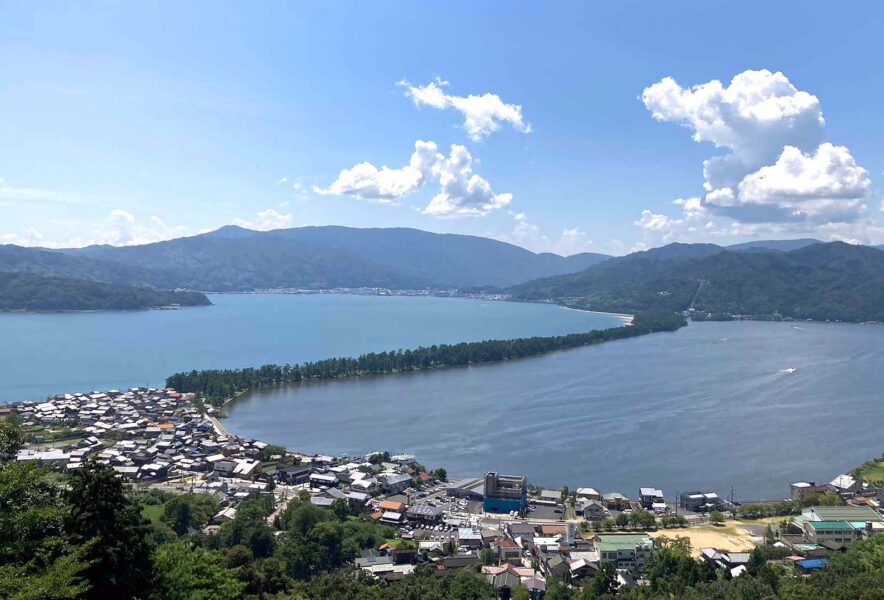Today’s stroll Amanohashidate, the breath of myth
Matsushima in Miyagi Prefecture, Miyajima in Hiroshima Prefecture, and Amanohashidate in Kyoto Prefecture are known as the “Three Views of Japan” and have been praised for their scenic beauty since ancient times. This time, we will take a walk at Amanohashidate, one of the three most scenic spots in Japan. Amanohashidate is one of the three most scenic spots in Japan. The sandbar with lush pine trees running through the sea is a mysterious view that cannot be seen anywhere else. Let’s take the time to view it from various locations.
- Kyoto Strolling Today’s route
- Kyoto Stroll Amanohashidate Starting from the cable car and lift station
- A.Amanohashidate Cable Car and Lift with spectacular views (Fuchu Station)
- B.Amanohashidate Kasamatsu Park, the birthplace of the “upside-down crotch peeking
- C.Motoise kono-jinja Shrine, the “original” shrine of Ise Jingu Shrine
- D.Amanohashidate sightseeing boat and Ichinomiya station with a spectacular view close by.
- E.Strolling in Amanohashidate
- Kyoto Stroll: Amanohashidate, a breath of mythology Route Review
- Kyoto Stroll: The official site of Amanohashidate, the breath of myth
- Kyoto Stroll Amanohashidate, the breath of myth Recommended Nearby
Kyoto Strolling Today’s route
A.Amanohashidate Cable Car and Lift Fuchu Station
B.Amanohashidate Kasamatsu Park
C.Motoise kono-jinja Shrine
D. Amanohashidate Sightseeing Boat
E. Amanohashidate
Kyoto Stroll Amanohashidate Starting from the cable car and lift station
A.Amanohashidate Cable Car and Lift with spectacular views (Fuchu Station)
This walk begins at the Amanohashidate cable car and lift station, where you can enjoy the beautiful scenery while riding.

The Amanohashidate cable car and lift station is located at the end of a narrow stone-paved path from the wide main street. There are not many, but there are many tasteful stores along the way. Since this is a sightseeing spot, let’s proceed while enjoying the view at a leisurely pace. At the end of the road, you will see Fuchu Station, the cable car and lift station.

So, let’s get started and take the cable car or lift up Mt. Since the tickets are the same and the fare is the same, you can choose the ride that best suits your mood. If you want to climb slowly and leisurely, we recommend the single-seater lift. It is a bit thrilling, so be careful if you are afraid of heights.
If you can get a window seat on the cable car, you can view Amanohashidate from inside the car. Choose a clear day as much as possible to enjoy the best view.
A 4-minute cable car ride or 6-minute lift ride will take you to “Amanohashidate Kusamatsu Park” located halfway up Mt.
B.Amanohashidate Kasamatsu Park, the birthplace of the “upside-down crotch peeking
Amanohashidate Kusamatsu Park is located halfway up Mt. Although it is called a park, it does not have playground equipment for children. The main attraction is an observatory from which visitors can view Amanohashidate from the north. Incidentally, there is a small amusement park called “Amanohashidate Viewland” on the opposite side of Kusamatsu Park, which is a place where both small children and adults can enjoy.
The view of Amanohashidate from Kusamatsu Park is named “Hiryu-kan” (“View of the Flying Dragon”). This name comes from the fact that the view of Amanohashidate from the south looks like a dragon rising into the sky.The green land stretching slightly crookedly in the blue sea. It is truly like a majestic dragon, and it is enchanting.
Kusamatsu Park is also regarded as the birthplace of “crotch peeping. As the name suggests, “crotch peeking” is a method of looking at Amanohashidate through the crotch. In this way, Amanohashidate looks like a bridge spanning the heavens.Please dress appropriately and enjoy the spectacular view.
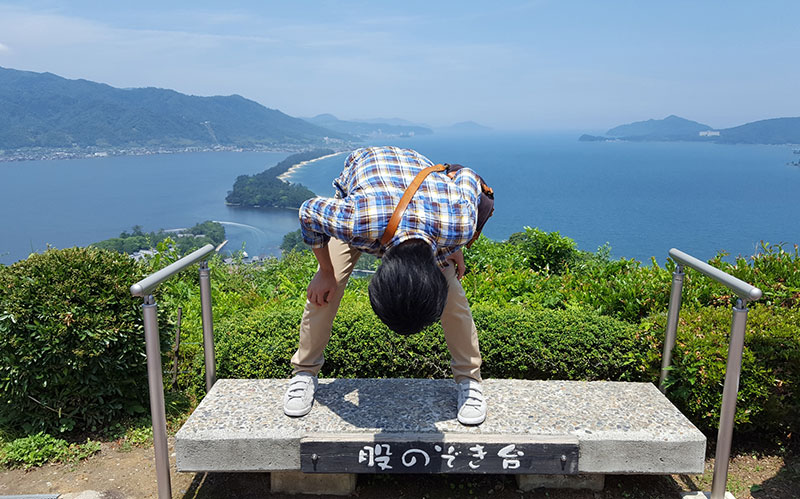
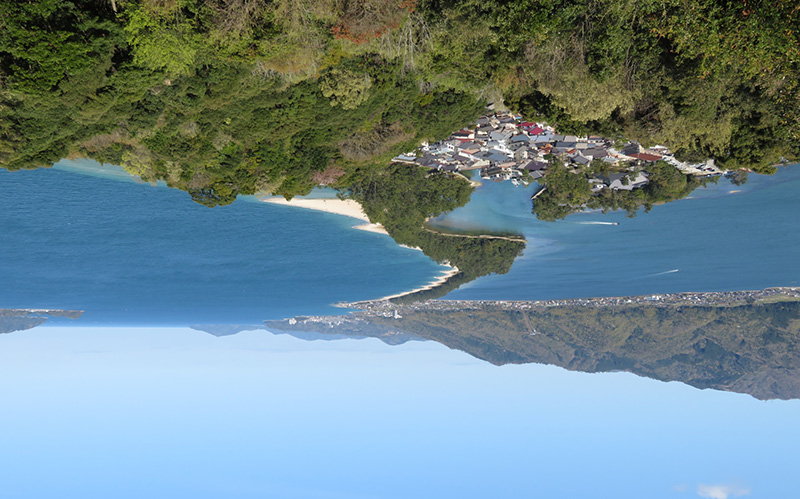
After viewing Amanohashidate from the observatory and enjoying the spectacular view, let’s go to the Kawarake-throwing.
Kawarake-throwing is a ritual to pray for good luck by throwing a round disc-shaped ceramic piece (Kawarake) at a ring at the end of a pillar. If the straw wreath passes through the circle, it is believed to bring good luck.The straw rope does not fly in the desired direction. It may seem simple, but it is a difficult task, and will be a good memory of your trip.
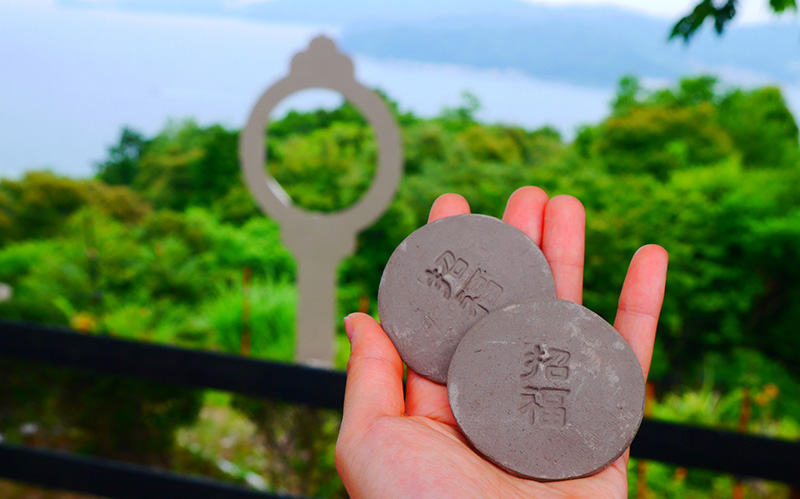
Once you have had your fill of Umbrella Pine Park, let’s move on. Take the lift or cable car that you took when you came to the park and go down the mountain. You can enjoy twice as much by using a different method than the one you took on the way to the park. After descending the mountain, take the road immediately after exiting Fuchu Station, the cable car stop, in the direction to the left. Walk along the stone-paved path. As you walk along the path with souvenir shops and coffee shops on the side, you will soon see the Motoise kono-jinja Shrine
C.Motoise kono-jinja Shrine, the “original” shrine of Ise Jingu Shrine
Among the many shrines in Japan, the Ise Jingu Shrine in Mie Prefecture is exceptional. Even those who have little interest in shrines may have visited it.

Motoise kono-jinja Shrine is the original shrine of Ise Jingu Shrine. Amaterasu and Toyoke were enshrined here for four years before they moved to Ise Jingu Shrine. Even today, the main deity is Hiko Hoakarinomikoto (grandson of Amaterasu and brother of Niniginomikoto), and Toyoke and Amaterasu are also enshrined here.When you visit Motoise kono-jinja Shrine, make sure to pay your respects and see the main shrine structure.
The main hall of Motoise kono-jinja Shrine is built in the Shinmei-zukuri style, which is the same as that of the Ise Jingu Shrine. The Shinmei-zukuri is said to be modeled after a palace and is one of the oldest architectural styles in Japan, along with the Taisha-zukuri (Izumo-jinja Shrine, etc.) and Sumiyoshi-zukuri (Sumiyoshi-taisha Shrine, etc.).
The shrine is also adorned with beautiful five-colored suetama, or “seat balls,” on the high columns of the pavilions. These are very rare and can only be found at Ise Jingu Shrine and Motoise kono-jinja Shrine. Please look for them when you visit the shrine.If you have visited the main shrine and strolled around the area, be sure to visit the inner shrine, Manai Shrine, located at the back of the grounds!
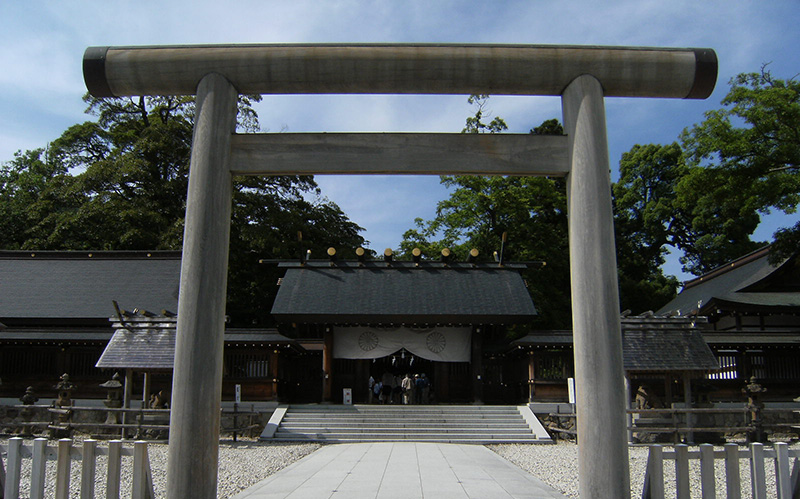
Behind the Manai Shrine, two rock formations, the rocks themselves being the deities, are located. The rock pavilions preserve a form of ancient rituals, and are a form of animism.The main rock formation behind the hall of worship is believed to be the main deity Toyouke, and is believed to bring blessings for a good harvest. The other western part of the shrine is dedicated to Amaterasu and the husband and wife deities Izanagino-no-mikoto and Izanami-no-mikoto, who are believed to bring good luck in marriage and family safety.
The Manai Shrine’s rock formation is a scene of ancient beliefs that have continued uninterruptedly. There is also a sacred well that is said to reflect the water used by the gods, creating an overall atmosphere of mystery.Those who wish to experience the breath of ancient times are encouraged to take the time to walk around.
After carefully exploring Motoise kono-jinja Shrine, including Manai-jinja Shrine, proceed to your next destination.After leaving Motoise kono-jinja Shrine, turn onto the main street and enter the narrow cobblestone street directly in front of the shrine. Be sure to cross the street at the pedestrian crossing on your left (with Kago-jinja Shrine behind you), as there are many cars on the street.
Follow the stone-paved path straight to the end of the street, and you will see the sightseeing boat pier.
D.Amanohashidate sightseeing boat and Ichinomiya station with a spectacular view close by.
The Amanohashidate sightseeing boats provide marine transportation between the north and south sides of Amanohashidate. There are three stations: Ichinomiya Station on the north side, Amanohashidate Pier on the south side, and Miyazu Pier further east from there. Both one-way and return trips are possible.
Earlier, we enjoyed Amanohashidate seen from high above. Now let’s enjoy the 12-minute boat ride from Ichinomiya Station to Amanohashidate Pier.
The sightseeing boats run on the west side of Amanohashidate. There, you can see a row of lush pine trees. Amanohashidate seen from the sea has a completely different atmosphere from that seen from a high place. Seagulls will be running alongside the boat. You can even feed them, so animal lovers should give it a try.
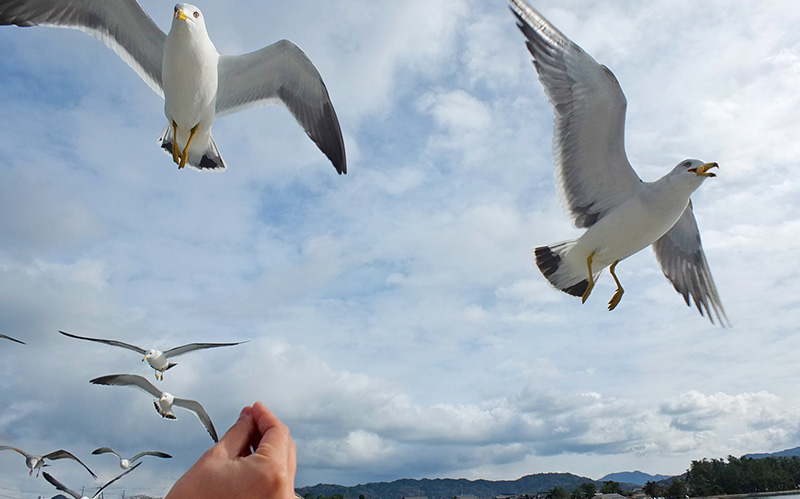
Time on board is leisurely. The beautiful scenery and the pleasant sea breeze will help you to forget the stresses of your daily life.After the 12-minute boat ride, turn left at the station. You will now cross over Amanohashidate on foot.
From the Amanohashidate Pier, walk along the gravel road along the sea. On the right side is Chion-ji Temple, one of the three monju temples in Japan, where you can see the magnificent Sanmon Gate. After passing the gate, you will come to a shopping street, and immediately turn left on the road.
Immediately after the turn, you will see a bridge with a red parapet. This bridge is called “Kaisenkyo Bridge” and is unusual in that it turns 90 degrees when a ship passes over it. After crossing the bridge and proceeding further, you are already at Amanohashidate.
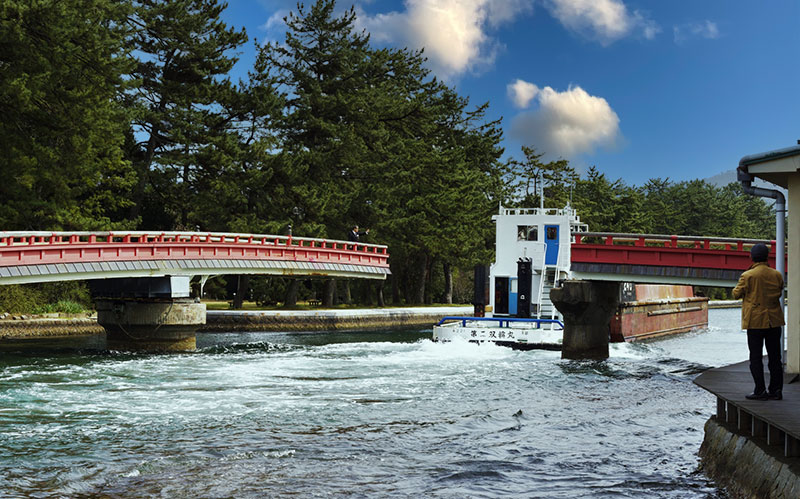
E.Strolling in Amanohashidate
Now, let’s walk inside Amanohashidate, which we have only gazed at so far.
The total length of Amanohashidate is about 3.6 km, and it takes about 50 minutes to walk to the other side of the river. It takes about 50 minutes to reach the other side of the river on foot. If you are not confident about your physical strength, renting a bicycle is also recommended.

As you walk through Amanohashidate, you will see long lines of beautiful pine trees and sandy beaches. As you gaze at them, ponder the legend of Amanohashidate.

One of the legends of Amanohashidate is written in “Tangokuni Fudoki,” which was established in the 8th century.In the age of the gods, Izanagi no Mikoto, who lived in heaven, brought down a long ladder from heaven to the earth to visit his wife, Izanami no Mikoto, who lived at Manai Shrine. However, the ladder collapsed while Izanagi no Mikoto was sleeping. That ladder is the Amanohashidate.
Izanagi no Mikoto and Izanami no Mikoto are important husband and wife deities who created the foundation of the land of Japan. Amanohashidate is the ladder where these two gods and goddesses meet, which is a very romantic story.
Walking along Amanohashidate, you will see various stone monuments and memorials along the way. There are monuments to Matsuo Basho, Yosa Buson, and other well-known haiku poets, so if you are interested, take a look at them. Amanohashidate Shrine on the way is small but famous as a power spot and one of the places you should definitely visit.Rest areas and restrooms are scattered throughout Amanohashidate. If you get tired, take a break and relax and enjoy the scenery. The sea breeze will help you to relax.
Finally, end your walk with a look at the Ssoryu-no-matsu pine tree on the north side of Amanohashidate.Souryu-no-matsu was originally a famous pine tree that stood in Amanohashidate. However, it was toppled by the damage caused by Typhoon No. 23 that hit Japan in 2004. And it has been preserved in its original form.
The Ssangyong pine tree is so huge that one can almost feel the horror of the typhoon that toppled such a large tree. It is said that 247 pine trees fell down in Amanohashidate during the same typhoon.After a short walk, you will come to the path leading to Ichinomiya Bridge, which was on the boat. Thank you again for your hard work.
Kyoto Stroll: Amanohashidate, a breath of mythology Route Review
A.(Start) Amanohashidate Cable Car and Lift Fuchu Station
↓ Cable car: 4 minutes / Lift: 6 minutes
B. Amanohashidate Kasamatsu Park
↓ 71m
C. Motoise kono-jinja Shrine
↓ 84m
D. Amanohashidate Sightseeing Boat
↓ 12 minutes to Amanohashidate Pier
E. (Goal)Amanohashidate
(to the north of Amanohashidate) 3.6km
Kyoto Stroll: The official site of Amanohashidate, the breath of myth
・Amanohashidate Cable Car and Lift Tango Kairiku Kotsu Co.:Click here
・Amanohashidate Kusamatsu Park Amanohashidate Tourist Association Official Website:Click here
・Motoisekono-jinja Shrine Official Site:Click here
・ Amanohashidate Sightseeing Boat Tango Kairiku Kotsu Co.:Click here
